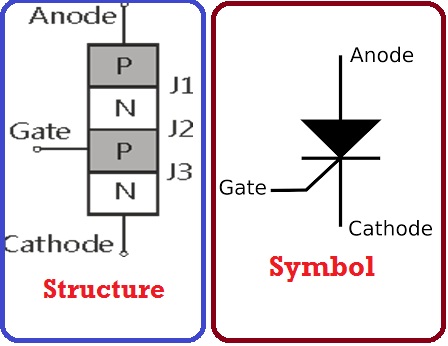
What is SCR-Silicon Controlled Rectifier ?
Monday, April 20, 2020
Edit
Silicon
Controlled Rectifier (SCR)
A
silicon controlled rectifier is a semiconductor device that acts as a true
electronic controlled switch. It can change AC and at the same instant it can control the quantity of power fed to the load. SCR combines the features
of a rectifier and a transistor.
SCR
is a four layers , three terminals (anode
- P-layer, cathode - N-layer (opposite end), gate - P-layer near
the cathode) & three (J1, J2 & J3) junction device.
This
device acts as a switch which is much more cheaper than a
relay and is
in a position to handle very
large amount of power dissipation.
•A gate signal controls switching action of SCR.
Which control from OFF state (high resistance) to ON state (low resistance).
Working & V-I characteristics of SCR: It is operated in three
modes known as a)Forward Blocking(OFF) state b)Forward conduction(ON) state
& c)Reverse blocking(OFF) state.
V-I characteristics of SCR means the graph between
anode current(Ia) & anode to cathode voltage (VAK) of
SCR.
Forward
blocking and Conduction state:-
Thyristor (SCR)
has three p-n junctions (J1, J2, J3 from the anode).When anode is at a positive
potential (VAK) w.r.t cathode with no voltage applied at the gate, junctions
J1 & J3 are forward biased, but junction J2 is in reverse biased.
– As
J2 is in reverse biased, no conduction takes place, so SCR is in forward
blocking state (OFF state).
– When VAK (forward voltage) is increased , forward
leakage current will flow through the device.
– When
this forward voltage reaches to breakdown voltage (VBO)
of the SCR, forward leakage current will reach saturation and reverse
biased junction (J2) will have avalanche breakdown and thyristor starts
conducting (ON state), referred to as forward
conducting state .
Reverse
blocking state:-
•When cathode is made more positive w.r.t anode, Junction J1 & J3 will be reverse
biased and junction J2 will becomes forward biased.
• A
small reverse leakage current flows, this state is referred as reverse blocking
state.
•If cathode is made more and more positive, stage is reached when both junctions J1 & J3 will be breakdown, this voltage is referred as reverse breakdown voltage (OFF state), and device is in reverse blocking state.
SCR Application:
• Gate Turn Off
switch (GTO)
• Electronic
(pointless) automotive ignition
SCR Specifications:
Forward-breakover voltage (VBO): The voltage at which the SCR enters the
forward-conduction region.
Latching Current:-At the breakover voltage the value of anode current is called as latching
current(IL).Current starts flow at IL. SCR once turned
on, gate potential can be removed and the SCR still conducts called LATCHING of
SCR.
Once it turn on it remains on even after elimination of the gate signal, as long as a
minimum current, the holding current (Ih) is maintained in the circuit. To turn off the SCR, anode current(Ia) must be reduced
to less than the holding current (Ih).
Holding current(IH): This is the value of anode current below which the
SCR switches from the forward-conduction region to the forward-blocking region.
Gate trigger current (IGT) :This amount of gate current necessary to
switch the SCR from the forward-blocking state to the forward-conduction state under specified conditions.



